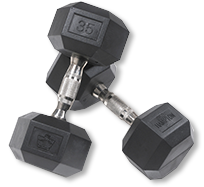As the popularity of triathlons grows among women, there's something that's impossible to ignore: These multisport females have amazing figures.
When you consider their disciplines, it's not that shocking, since swimming, biking, and running engage almost every major muscle group, but in different ways. Swimming hits your arms, back, shoulders, and core. Cycling mainly works your quads, while running targets your hamstrings. The result: You get the arms of a swimmer, the legs of a cyclist, and the leanness of a runner—all in one super-sexy package.
The swim-bike-run combo doesn't appeal to you? Not to worry. Other workout combos can be just as effective as—if not more than—the classic triathlon, says L.A.-based fitness expert Holly Perkins. "The key is exercise variability, which helps you feel and look better and gets you in better overall shape," she says.
Not only will the fitness gains you make in one workout score you points in another —e.g., aerobic endurance built in the pool will make any run feel easier—but you'll have more fun too. "Doing different workouts keeps you mentally stimulated and physically challenged," says exercise physiologist Tom Holland. "You'll also have fewer aches and pains, since overuse injuries tend to happen when you pound the same parts of your body over and over."
We consulted top experts to create four carefully crafted multisport combos. Call them the new triathlons. In each, the activities complement one another to sculpt a balanced body and deliver well-rounded fitness. Pick any plan to blast fat, strengthen every muscle, and look hotter than ever.

TRI #1 / Cycling, Rowing, Boot Camp
Best For: Gym Rats
Before you wimp out when your indoor cycling instructor tells you to crank up your resistance during class, consider this: Steep climbs help build lean muscle mass in your glutes, quads, and hamstrings, which can help decrease the appearance of cellulite and create sleek definition, says Holland. (Umm, yes please!) And the cycling sprints? High-intensity efforts help increase your base fitness level, as well as spike your post-workout calorie burn.
For balance, steady rowing strengthens your shoulders, upper back, and core while improving your cardiovascular endurance. And boot camp doesn't just build calorie-burning muscle from head to toe; when you strengthen your chest, back, shoulders, and legs with staples like push-ups and squats, rowing and spinning feel much easier with every subsequent workout.
Complete each activity twice a week.
Cycling
Take a class, or if you're on your own, ride for 45 to 60 minutes. Do both seated and standing sprints to work all of the major muscle groups in your legs. Changing your body position shifts the demand among your glutes, quads, and hamstrings.
Rowing
Row for 30 to 50 minutes at a moderate pace. You should be able to carry on a conversation throughout the entire workout.

Boot Camp
If you can't find a boot camp near you, look for classes with terms like cross-training, metabolic, sports conditioning, or strength cardio, all of which will offer similar benefits. Or try our at-home routine below.

Read More: The Superfast Total-Body Workout
TRI #2 / Swimming, Boxing, Sprinting
Best For: Fast-Tracking a Flat Belly
Most workouts keep you moving in one direction—like running, where you plant one foot in front of the other. This combination utilizes different planes of motion—forward while sprinting, unilateral while swimming, and rotational while boxing—to build functional strength from head to toe. Not to mention making sure that no muscle goes untrained!
This mix also gives you built-in recovery. Since both boxing and sprinting are high-impact, intense activities, the steady-pace swim lets your muscles and joints recover while improving your cardiovascular endurance. And because all three activities rely heavily on core strength, every sweat session will work to whittle your waistline.

Sprint one or two times a week, box one or two times a week, and swim three or four times a week. Choose one workout each day, and take off one day per week to recover.
Swimming
Swim at a steady pace for at least 30 minutes.
Boxing
Find a kickboxing or boxing class, or follow a DVD like Aerobox ($35, aerospacenyc.com). Be sure to brace your core when you kick and punch.
Sprints
After warming up, sprint for 10-15 seconds at a pace that's close to your all-out max. Rest for 2-3 minutes, and repeat 6-10 times.
Read More: The 10 Best Butt Exercises
TRI #3 / Elliptical, Strength Training, Pilates
Best For: Injury-Prone Women
If you're often sidelined by soreness or you're coming back from an injury, this combination avoids joint-pounding, high-impact activities. The elliptical builds cardiovascular endurance but won't do much to increase muscle strength or endurance. That's what the strength training is for. And to sculpt rock-hard abs and keep injuries at bay throughout your entire body—especially your core and the muscles that support your joints—round out the program with stability-enhancing Pilates.
Complete each activity twice a week.
Elliptical
Pedal forward for 5 minutes, then in reverse for 1 minute. Repeat for 40 minutes. You should be breathing hard.

Strength Training
Do 15 reps of each move below without resting between exercises. Repeat four times total. Start with light dumbbells—say, 5-8 pounds.
Pilates
Take a class or pop in a DVD like any by Stott Pilates. Focus on technique to really engage your core.
1. Dumbbell Squat

Holding dumbbells at your sides, feet hip-width apart, lower your body until your thighs are parallel to the floor. Return to standing.
2. Chest Press
Lie face-up on a bench with dumbbells at chest height, elbows bent. Straighten your arms to press the weights toward the ceiling; lower back to start.
3. Lat Pull-Down
Sit at a lat pull-down machine and grab the bar just outside your shoulders. Slowly pull the bar to your chest, then reverse back to start.
4. Shoulder Press
Stand with your feet hip-width apart and hold a pair of dumbbells at shoulder height. Press the dumbbells up directly above your shoulders. Slowly lower them back to start.
Read More: The Best Indoor Cycling Workout
TRI #4 / Running, Plyometrics, Yoga
Best For: Fast Fat Loss
If you want to blast calories but you're short on time, pick this plan. Instead of logging loads of miles, you'll maximize your time on runs by switching between a steady pace to build aerobic endurance and tempo runs to boost caloric burn and steer clear of plateaus.
To speed fat loss, you'll add plyometrics—explosive moves like hops and jumps—which burn calories long after your workout ends, says strength and conditioning specialist Robert Dos Remedios. "Plus, they give women a more developed butt and legs by recruiting type-II muscle fibers, which have a greater growth capacity," says exercise physiologist Jason Karp, Ph.D.

Yoga counteracts runners' tight hip flexors and hamstrings by improving flexibility while increasing upper-body strength for all-around definition.
Complete a plyometric workout once or twice a week, run 2-4 times a week, and practice yoga 2-4 times a week. Do one workout per day, and rest one day a week.
Plyometrics
If your gym doesn't offer a plyometrics-based class, try the "Power Plyos" routine below, from Dos Remedios.
Running
Switch between steady-state runs—at least 30 minutes at a moderate pace—and tempo runs. In tempo runs, jog easy for 10 minutes, run 20 minutes at a hard but sustainable pace, then jog easy for 10 minutes.
Yoga
If you're doing yoga within one day of the plyometrics, choose a gentle yoga practice to help your muscles recover.
Complete 3 sets of each move, resting 30-60 seconds in between sets. Finish all sets before moving on to the next exercise.
Squat Jump
Stand with your feet hip-width apart and bend your knees to lower your body until your thighs are parallel to the ground. Straighten your legs and jump as high as you can, landing softly and immediately going into the next rep. Do 10.
Skater Jump
Stand with your feet together, jump to your right, and land on your right foot, knee bent. Quickly push off and jump to your left, landing on your left foot. That's one rep Continue bounding back and forth for five reps.
Power Skip
Raise one knee and skip as high as you can off the ground, landing in the same spot and on the same leg you used to jump. Do five, then switch legs and repeat.



Perform each move for one minute, without resting between exercises. Do three times total.
Walking Lunge
Step your right foot forward and lower until both knees form 90-degree angles. Press through your right heel and bring your left foot forward to stand. Continue, alternating sides.
Push-Up
Place your hands on the floor directly under your shoulders and extend your legs straight behind you. Lower toward the ground, elbows close to your body; press back to start.
Bicycle Crunch
Lie on your back, hands behind your head, legs straight. Lift your shoulders, twist your torso to the left and bend your left knee toward your right elbow. Repeat to the other side; continue alternating.
Plie Squat
With your legs wide apart and toes facing out, bend your knees to lower toward the floor; return to stand.
Jumping Jacks
Stand with your feet together, arms at sides. Jump up, raising your arms overhead and spreading your feet out. Jump back to start.